|
Athens and Rome
Two ancient cities have a lot more in common than we knew
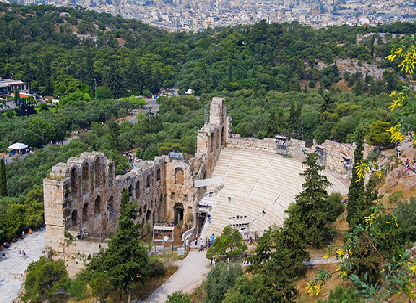 Athens is known as the cradle of Western civilization and the birthplace of democracy
. Rome conquered Greece and then adopted its architecture of domes and arches to build some of the most impressive aqueducts and buildings still standing today. A recent visit to both
cities during our Mediterranean cruise highlighted their similarities and their differences. Athens is known as the cradle of Western civilization and the birthplace of democracy
. Rome conquered Greece and then adopted its architecture of domes and arches to build some of the most impressive aqueducts and buildings still standing today. A recent visit to both
cities during our Mediterranean cruise highlighted their similarities and their differences.
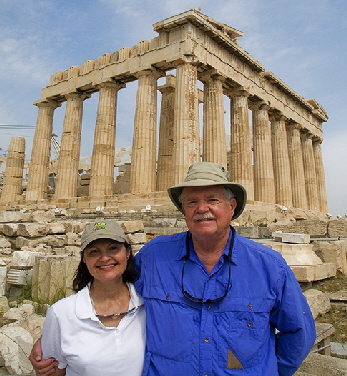 A visit to Athens is not complete without a visit to the Parthenon. Construction of this Greek
temple, which has dominated the city skyline for thousands of years and was built in honor of the goddess Athena, began in 447 BC and was completed in 10 years. It is most definitely the
most important building of Classical Greece and one of the world's greatest cultural monuments. Extensive restorations are under way to insure the stability and authenticity of these fabulous
ruins. The difficulty of the restorations themselves is a testament to the workmanship and knowledge of the original architects and builders, who did
not have the type of equipment used in modern times. A visit to Athens is not complete without a visit to the Parthenon. Construction of this Greek
temple, which has dominated the city skyline for thousands of years and was built in honor of the goddess Athena, began in 447 BC and was completed in 10 years. It is most definitely the
most important building of Classical Greece and one of the world's greatest cultural monuments. Extensive restorations are under way to insure the stability and authenticity of these fabulous
ruins. The difficulty of the restorations themselves is a testament to the workmanship and knowledge of the original architects and builders, who did
not have the type of equipment used in modern times.
 |
What most people may not realize is that the Parthenon was built on top of an even older temple of Athena, destroyed approximately 40 years before the
current building rose. As many of the significant historical buildings of its time, the Parthenon has lived several lives – as a treasury, as a Christian church and as a
mosque and military fort during the Ottoman Turk conquest. It was during this period when some of the original marble sculptures – called the Elgin Marbles –
were removed and purchased by the British Museum. Today, these impressive statues are a subject of controversy between Greece and Britain, as Greece would like them returned.
This ancient site is suited only for visitors who are in good physical shape. You can
only get there by slowly climbing several hundred feet of rough and often slippery stones to the flat hill top. Climbing towards the top is impressive in itself; a
massive stone wall from an even more ancient fort still remains supporting the hillsides. Once you pass the entry gate, you are guided on a path that goes
through the massive walls of the Temple of Athena Nike. Visitors are monitored closely by local curators who make sure that nobody steps out of the path and
into areas that are still being restored. Once at the top, several other ancient buildings that formed part of the Acropolis have also been restored and provide a magnificent experience.
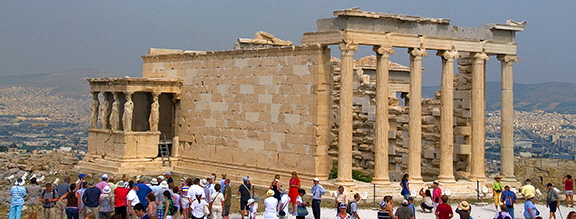 |
For example, the Erechtheum designed and built by Phidias who was also employed to build the Parthenon. Among the most unique aspect of this building
is the famous "Porch of the Maidens", with six draped female figures (called caryatids) as supporting columns, each sculpted different from the rest and
engineered in such a way that their slenderest part, the neck, is capable of supporting the weight of the roof while remaining graceful and feminine. However,
the statues at the ruins are replicas; the originals are in the new Acropolis Museum.
Even when there are crowds, like during our visit, you can find a quiet spot to
admire the architecture and magnitude of each building in detail. The view of Athens from the top is spectacular, and if you look over the walls towards the
bottom of the old fort walls you can see even more ruins, including the Theater of Dionysus which is still used today for concerts.
Even a two-hour visit to the Acropolis didn't seem enough to absorb the history
of that place. We left with a sense of awe of the amazing culture and knowledge that created such a magnificent site for eternity.
Rome
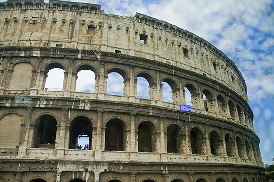 What the Parthenon is to Athens, the Colosseum is to Rome. On our short stop in Calcavecchia (the port city near Rome)
we chose to take a "drive-by" tour of the major highlights. There's no way a visitor to Rome can say they were there without seeing this medieval Colosseum. The
massive elliptical amphitheater was built in just 8 years in the center of the city and is the largest ever built in the Roman Empire. It is considered one of the greatest works
of Roman architecture and engineering. It could seat approximately 50,000 spectators, about the same as some football stadiums today. The Colosseum's
size and the gladiatorial combats it hosted are an excellent example of Roman history, its conquests, and its influence in the Mediterranean and subsequently the fall of the Empire. What the Parthenon is to Athens, the Colosseum is to Rome. On our short stop in Calcavecchia (the port city near Rome)
we chose to take a "drive-by" tour of the major highlights. There's no way a visitor to Rome can say they were there without seeing this medieval Colosseum. The
massive elliptical amphitheater was built in just 8 years in the center of the city and is the largest ever built in the Roman Empire. It is considered one of the greatest works
of Roman architecture and engineering. It could seat approximately 50,000 spectators, about the same as some football stadiums today. The Colosseum's
size and the gladiatorial combats it hosted are an excellent example of Roman history, its conquests, and its influence in the Mediterranean and subsequently the fall of the Empire.
Certain areas of the exterior have been fully renovated and cleaned, showing a
remarkable difference and beautiful carvings and decorations. As is usual in Europe, car exhaust and other pollutants have unfortunately contributed to the
deterioration of many of the most ancient buildings and statues which are often located in the middle of the cities. This is something that could not be foreseen
several thousand years ago.
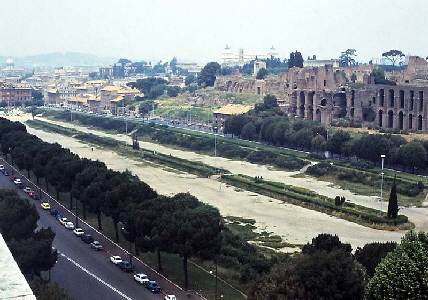 Visitors are allowed to walk through certain areas of the Colosseum's interior, but we didn't have time on this visit. We only had enough time
to drive by some of the major highlights, which included the Arch of Constantine located adjacent to the Colosseum, and the impressive remains of the Circus Maximus where the
famous chariot races occurred. We also had a little time to walk through St. Peter's Square in the Vatican City. There were two maps in the square depicting the various areas of Visitors are allowed to walk through certain areas of the Colosseum's interior, but we didn't have time on this visit. We only had enough time
to drive by some of the major highlights, which included the Arch of Constantine located adjacent to the Colosseum, and the impressive remains of the Circus Maximus where the
famous chariot races occurred. We also had a little time to walk through St. Peter's Square in the Vatican City. There were two maps in the square depicting the various areas of
the plaza, unfortunately, one map was totally vandalized and the other was nearly washed out by time. Other places we wished we could have seen were the
Catacombs and the Pantheon. But we have to leave something for the next time!
|